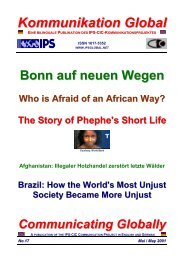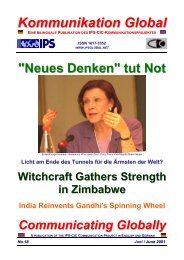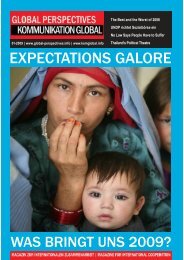GLOBAL PERSPECTIVES | Second Quarterly 2013 â North America ...
GLOBAL PERSPECTIVES | Second Quarterly 2013 â North America ...
GLOBAL PERSPECTIVES | Second Quarterly 2013 â North America ...
You also want an ePaper? Increase the reach of your titles
YUMPU automatically turns print PDFs into web optimized ePapers that Google loves.
<strong>GLOBAL</strong> <strong>PERSPECTIVES</strong> - SECOND QUARTERLY <strong>2013</strong><br />
into force, after all states join), some states—as one example,<br />
Israel—likely would not sign the nuclear ban.<br />
3. Under the worldwide NWC, the actual weapons (warhead)<br />
elimination period does not begin until after states<br />
mutually approve of all states’ nuclear ban domestic (national)<br />
implementing legislation (to ensure that such legislation<br />
does not undermine the ban), plus mutually approve<br />
of fellow states’ level of cooperation in providing treatyrequired<br />
declarations of nuclear weapons, facilities, and<br />
materials, with this including cooperation in baseline,<br />
achievable verification of the declarations by international<br />
nuclear ban inspectors… This provision is likely necessary<br />
for today’s nuclear weapon states because they may be<br />
somewhat “wary” about abolition even as the ban’s initial<br />
major steps unfold (i.e., states’ enactment of suitable implementing<br />
legislation, and then states’ nuclear declarations<br />
and their baseline verification). If it should happen<br />
that some state flouted its treaty obligations (on one of<br />
these crucial, initial treaty “roll-out” aspects), the treaty’s<br />
progress could be halted by a state and would not proceed<br />
to its essence (nuclear warhead elimination) until the situation<br />
is rectified.<br />
4. Warhead elimination [over posited 3.5 years] commences<br />
with Russia or the USA, whichever has more warheads,<br />
eliminating enough of them over six months to reach the<br />
other’s initial (lower) level – after which point both continue<br />
reducing, following the treaty’s timetable for warhead<br />
elimination. Also, and starting from that point when Russia<br />
and the USA are first “equal” (six months into elimination<br />
period): all other nuclear possessors eliminate 25 percent<br />
of their arsenals within 90 days; but thereafter they can<br />
“wait” until Russia and the USA in tandem reach the other<br />
states’ varying, much lower [and 25-percent reduced] levels,<br />
at which times they join the USA and Russia in further<br />
reductions leading to all states simultaneously reaching<br />
zero. This provision is intended to be a workable compromise<br />
for, on the one hand, Russia and the USA with their<br />
multi-thousand warhead arsenals, and also for the other<br />
nuclear possessors with their many fewer. . [IDN | April 6,<br />
<strong>2013</strong>] <br />
*Frederick N. Mattis is author of Banning Weapons of Mass Destruction, pub. ABC-Clio/Praeger Security International<br />
Image: www.amazon.com/Banning-Des truc tion-Securi ty-International-ebook/dp/B002AMVCGM<br />
- 41 -















